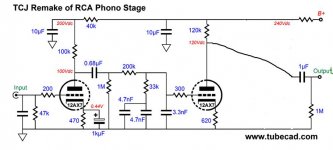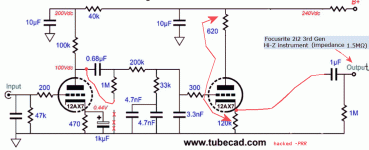Hello guys!
I've built a phono preamp based on John Broskie's schematic, minus the 12AT7 output stage.
Here is the ('modified') schematic i used:

Obviously its output impedance is pretty high and needs a high enough input impedance on the following stage.
RCA manual states it should be kept above 250kΩ.
Anyway, here's my specific problem:
I've been ripping records using various USB interfaces.
Using a Focusrite 2i2 3rd Gen at the moment, feeding signal into its Hi-Z instrument input (impedance specified @1.5MΩ).
All is good, up to the point I want to rip records using high-output MM cartridges.
For example using a Shure M44-7, even with gain knob at zero the inputs get overloaded and clipping occurs.
It's so bad there's hardly any record I can record without clipping.
So, my question to you guys is whether I could use an unbalanced, passive attenuator?
Placed between the source (as seen in the above schematic) and the interface's input (with its 1.5MΩ impedance).
But, without disturbing the impedance 'matching' too much for the reasons explained above.
A good target attenuation would be around 15-20dB.
That'd be enough I guess to keep levels low enough and not overloading the interface when using my favorite high-output MM cartridges.
It'd be really great if the passive attenuator consisted of a few resistors and the impedance seen by the source be kept above 750kΩ.
Obviously this is above my skills, so I ask you guys.
Hopefully you can help me out a bit.
Thank you for taking the time to read!
Kind regards,
Nikos.
I've built a phono preamp based on John Broskie's schematic, minus the 12AT7 output stage.
Here is the ('modified') schematic i used:
Obviously its output impedance is pretty high and needs a high enough input impedance on the following stage.
RCA manual states it should be kept above 250kΩ.
Anyway, here's my specific problem:
I've been ripping records using various USB interfaces.
Using a Focusrite 2i2 3rd Gen at the moment, feeding signal into its Hi-Z instrument input (impedance specified @1.5MΩ).
All is good, up to the point I want to rip records using high-output MM cartridges.
For example using a Shure M44-7, even with gain knob at zero the inputs get overloaded and clipping occurs.
It's so bad there's hardly any record I can record without clipping.
So, my question to you guys is whether I could use an unbalanced, passive attenuator?
Placed between the source (as seen in the above schematic) and the interface's input (with its 1.5MΩ impedance).
But, without disturbing the impedance 'matching' too much for the reasons explained above.
A good target attenuation would be around 15-20dB.
That'd be enough I guess to keep levels low enough and not overloading the interface when using my favorite high-output MM cartridges.
It'd be really great if the passive attenuator consisted of a few resistors and the impedance seen by the source be kept above 750kΩ.
Obviously this is above my skills, so I ask you guys.
Hopefully you can help me out a bit.
Thank you for taking the time to read!
Kind regards,
Nikos.
Attachments
Last edited:
....USB interfaces. Using a Focusrite 2i2 3rd Gen at the moment, feeding signal into its Hi-Z instrument input (impedance specified @1.5MΩ). ....
"Instrument" is not "Line", what the phono preamp is made to drive.
However modern ADC "Line" inputs are around 10k impedance. I do not know if the preamp would drive that with the stage you omitted, but it sure won't as it stands.
Why gain-up then cut-back? Move a few wires and parts.
Attachments
Dear PRR, thank you for the reply.
I really appreciate it.
Can you please elaborate a bit more on what you mean by that?
From my side, to elaborate a bit more on the input of that USB interface:
The USB interface, has one actual physical input.
When a button is pressed, just switches between 2 differently specified 'inputs paths'.
One called 'line' with 60kOhm specified impedance and the other is called 'instrument' with 1.5MOhm specified impedance.
They also have different iput sensitivities.
I choose to use the 1.5MOhm specified input, to emulate a high impedance tube line stage that'd follow the RCA-based phono stage in the old days.
I thought it'd be a matching load for it.
So maybe a bit easier than 10kOhm.
'Instrument' input must have a loading resistor of 1.5Mohm (instead of a 60kOhm for the 'line') in front af an opamp stage.
Which probably stands before the actual ADC chip.
I wish I had a schematic for the interface to see exactly what's in it.
The reason of building that particular phono was to have a passive RIAA network & anode follower output.
You might think i'm nuts, but I just wanted to try it for the supposed sonic benefits of it.
That is why I ask for a passive attenuator 'solution' in-between.
Its high output impedance creates problems though, so if the supposed sound purity isn't there, I'd try the cathode follower output you suggested.
I really appreciate it.
"Instrument" is not "Line", what the phono preamp is made to drive.
Can you please elaborate a bit more on what you mean by that?
From my side, to elaborate a bit more on the input of that USB interface:
The USB interface, has one actual physical input.
When a button is pressed, just switches between 2 differently specified 'inputs paths'.
One called 'line' with 60kOhm specified impedance and the other is called 'instrument' with 1.5MOhm specified impedance.
They also have different iput sensitivities.
I choose to use the 1.5MOhm specified input, to emulate a high impedance tube line stage that'd follow the RCA-based phono stage in the old days.
I thought it'd be a matching load for it.
From what is specified by Focusrite, the impedance for its 'line' mode is 60kOhm.Modern ADC "Line" inputs are around 10k impedance. I do not know if the preamp would drive that with the stage you omitted..
So maybe a bit easier than 10kOhm.
'Instrument' input must have a loading resistor of 1.5Mohm (instead of a 60kOhm for the 'line') in front af an opamp stage.
Which probably stands before the actual ADC chip.
I wish I had a schematic for the interface to see exactly what's in it.
Why gain-up then cut-back? Move a few wires and parts.
The reason of building that particular phono was to have a passive RIAA network & anode follower output.
You might think i'm nuts, but I just wanted to try it for the supposed sonic benefits of it.
That is why I ask for a passive attenuator 'solution' in-between.
Its high output impedance creates problems though, so if the supposed sound purity isn't there, I'd try the cathode follower output you suggested.
Last edited:

